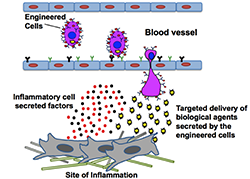 |
| Stem cells deliver drugs to inflamed tissue.--Courtesy of HSCI |
Researchers at several Boston-based institutions have developed a way to use stem cells to deliver an anti-inflammatory drug, repurposing the cells' genetic material to act as a sort of "drug factory" at the inflamed spot.
The team of scientists from Brigham and Women's Hospital, the Harvard Stem Cell Institute (HSCI), MIT and Massachusetts General Hospital inserted modified strands of RNA into mesenchymal stem cells, which gave the cells the ability to target sites of inflammation and release the anti-inflammatory drug interleukin-10. In mouse models, the treatment brought swelling down, according to a HSCI release.
The technique by which the researchers used messenger RNA to modify the cells was developed at MIT. Unlike DNA modification, this method conserves the cell's genome, making the stem cells safer when used as a treatment. Biological drugs like this one are not unheard-of in the clinic, but the proof-of-concept study published in the journal Blood may offer an improved result, according to the report.
Part of the problem is getting the stem cells to survive long enough in the bloodstream to have a therapeutic effect. So by rapidly targeting the cells directly to the inflamed tissue, as well as looking for ways to extend the lifespan of the cells, the researchers have been able to make the treatment more viable.
"If you think of a cell as a drug factory, what we're doing is targeting cell-based drug factories to damaged or diseased tissues, where the cells can produce drugs at high enough levels to have a therapeutic effect," lead author Jeffrey Karp of the HSCI said in a statement. Oren Levy, co-lead author of the study and Instructor of Medicine in Karp's lab, added, "This opens the door to thinking of messenger RNA transfection of cell populations as next generation therapeutics in the clinic, as they get around some of the delivery challenges that have been encountered with biological agents."
- here's the HSCI release
- and the research abstract